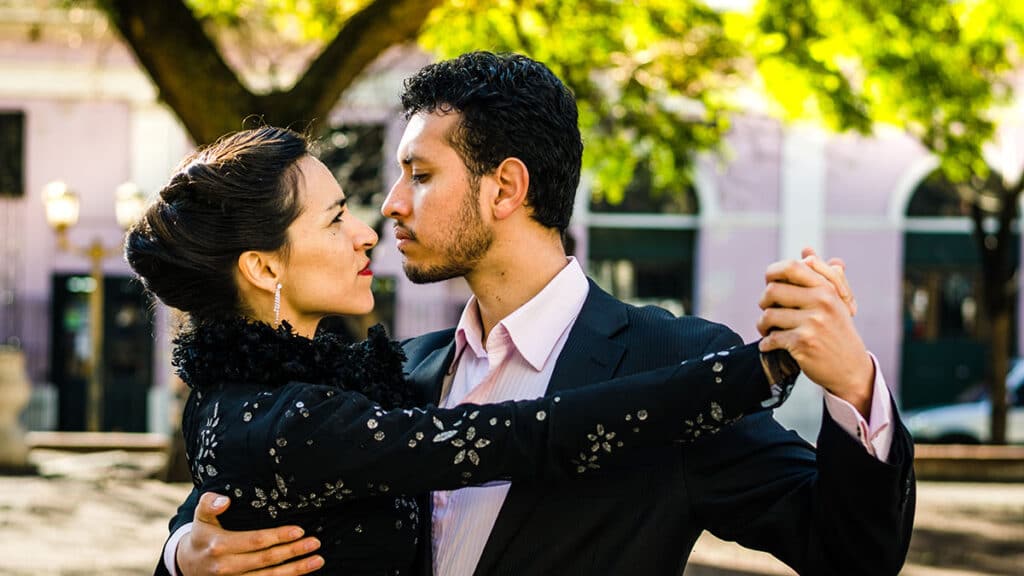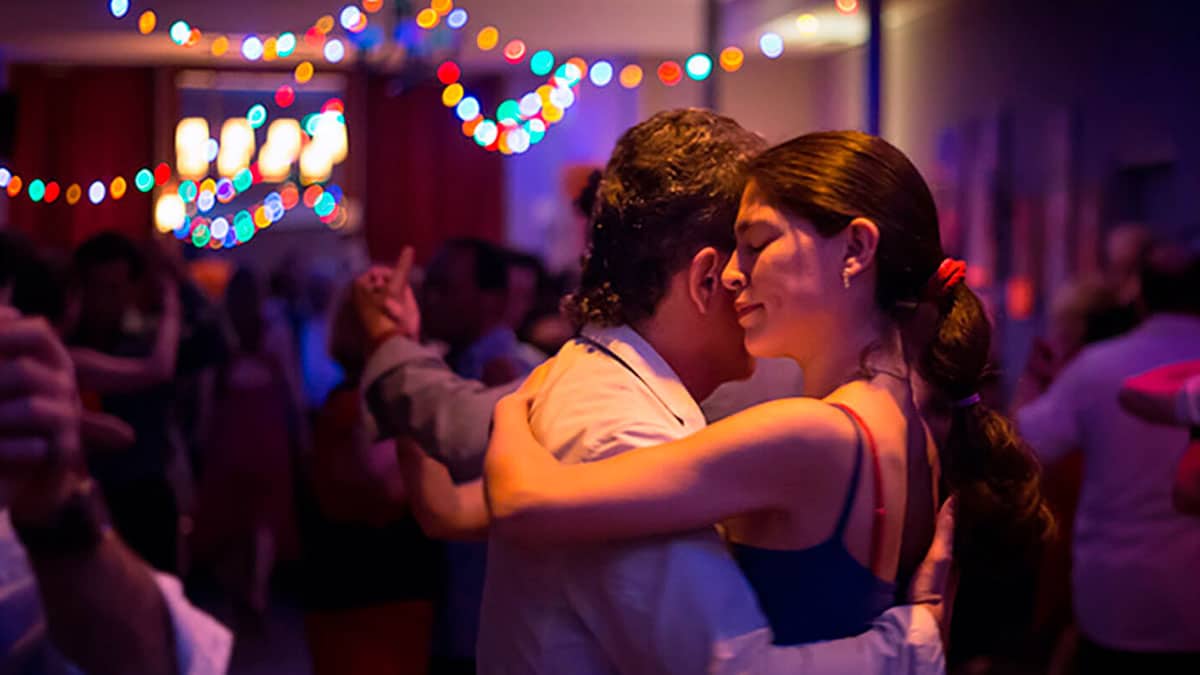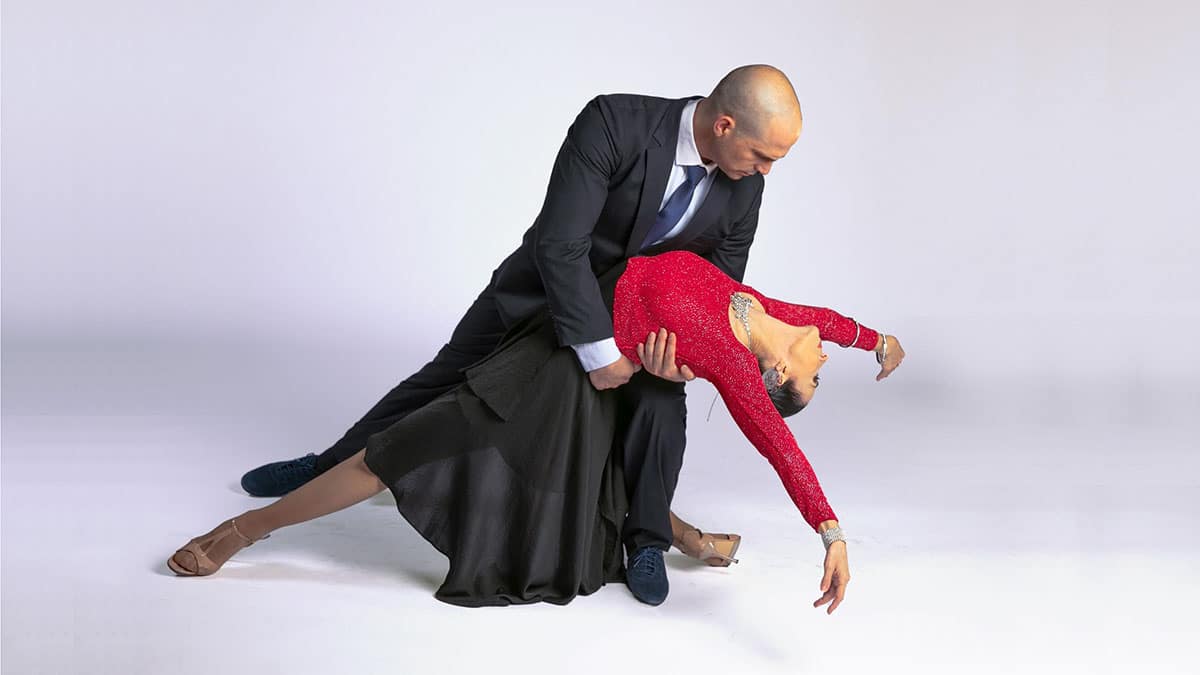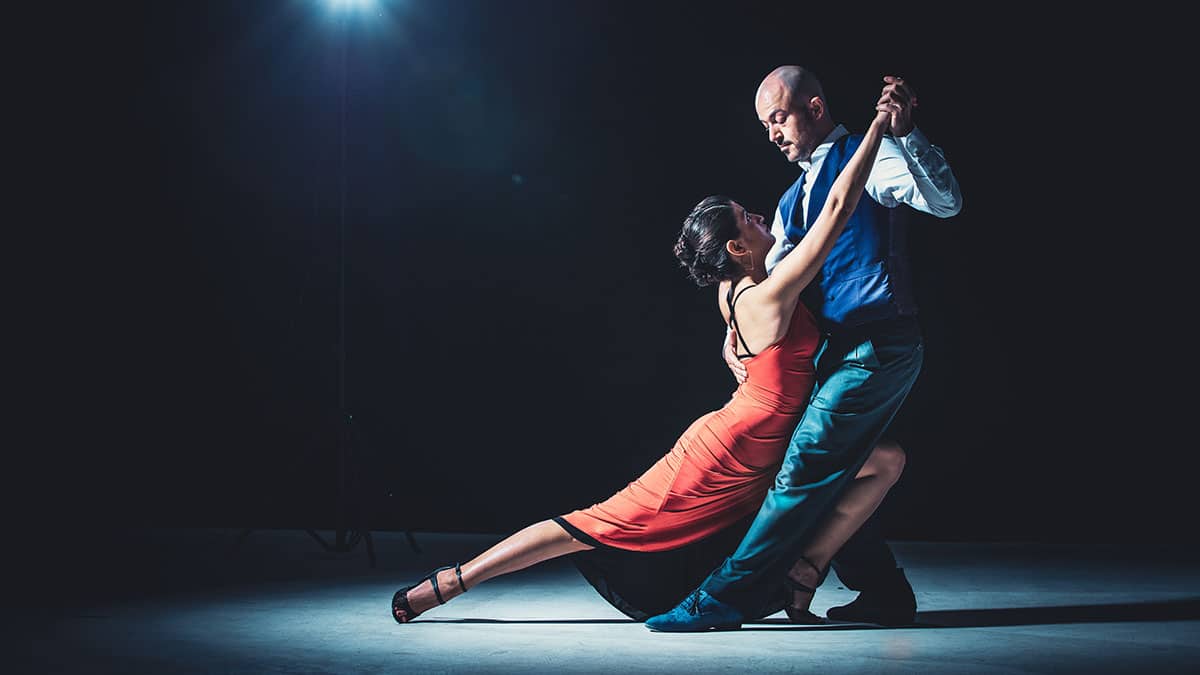The Tango Beat® in New York City is in dance studios, restaurants, bars, night clubs, social clubs, theaters, performing arts centers, and occasionally on Broadway.
You can dance tango every night in New York, often at two or three places.
New York Latin Culture Magazine launched as Tango Beat®, the world’s most popular tango magazine, in 2008. Editor “Kíko” Keith has been dancing tango since 2007. He is a student of Claude Murga who teaches diplomats for Argentina’s Ministry of Culture.
Tango is a Europeanized, African Diaspora drum, song, and dance tradition that evolved from:
- the Afro-Brazilian religion Candomblé in Bahia, Brazil;
- into candombe in Montevideo, Uruguay;
- into milonga in Buenos Aires, Argentina;
- and into tango in Buenos Aires and Paris, France, where it also picked up vals (European waltz).
Today we dance milonga, tango, and vals.
Thank you for sponsoring tango:
- All Night Milonga
- Distinguished Concerts International
- On Stage at Kingsborough
- Robert Browning Associates
- Rosa Antonelli
- Schimmel Center
- World Music Institute
- Worldtone Dance
Follow Your Heart to the Tango Beat
International Tango Day Celebrates the Dance of Love
BUENOS AIRES, Argentina ~ December 11 🇦🇷 🇺🇾 🇫🇷
Continue Reading International Tango Day Celebrates the Dance of Love
New York Tango News
New York Tango Beat®

NY Milongas
- The All Night Milonga NYC is one of New York’s biggest and longest-running milongas.
- Central Park Tango is an outdoor milonga in Central Park on summer Saturdays.
- El Destino hosts many of New York’s best dancers at Solas in Greenwich Village on Sunday nights. 🇺🇸
- Tango La Nacional is New York’s most traditional milonga. It’s at the La Nacional Spanish social club in Chelsea, Manhattan on Thursday nights. 🇦🇷
NY Tango Venues
- Bryant Park
- Central Park
- Centro Español de Queens
- The Django
- La Nacional Spanish social club
- Schimmel Center
- Thalia Spanish Theatre
Robert Browning Associates and the World Music Institute produce some tango shows.
NY Tango Bands
- Pedro Giraudo
- Astor Piazzolla learned to play bandoneon in New York City before he created “Nuevo Tango” (new tango) which remixed tango, jazz and classical traditions. 🇦🇷
- Bajofondo is the band of double Academy Award-winner Gustavo Santaolalla, who started rocking with Arco Iris in Argentina, but moved to Los Angeles where he is the father of Rock en Español which is now called Latin Alternative. 🇦🇷
- Carlos Gardel (1890-1935) was born in France, but became the iconic Argentine tango singer. His “Mi Noche Triste” (1915) set the melancholic tone of tango. After leaving New York, he died in a plane crash in Medellín, Colombia. 🇦🇷
- Gotan Project is a French band that launched the electrotango movement out of Paris in 1999. 🇫🇷
- JP Jofre is a New York Argentine bandoneón player.
- Osvaldo Fresedo was a tango composer known for his melodies. 🇦🇷
- Otros Aires is an electrotango band from Barcelona, Spain that plays contemporary versions of traditional tango. 🇪🇸
- Quinteto Astor Piazzolla is the Piazzolla Foundation tango orchestra. 🇦🇷
- Pedro Giraudo is a Latin Grammy-winning tango jazz bassist, composer, and leader. He knows how to play tango for dancers. 🇦🇷
- Raúl Jaurena was an Uruguayan bandoneón master who worked in New York a lot. 🇺🇾
- Rosa Antonelli is a New York Argentine Steinway concert pianist who plays classical music and tango. 🇦🇷
- Saul Zaks is an Argentine classical music conductor. 🇦🇷
- Tanghetto is an electrotango band from Buenos Aires. 🇦🇷
NY Tango Dancers
New York tango style is defined by former dancers of Luis Bravo’s “Forever Tango,” which opened in 1997. It’s a great show, but in New York everyone dances the same. That’s not how it used to be. Every dancer had their own style, and all the dancers respected that.
- Adriana Salgado and Orlando Reyes are US tango champions, originally from Colombia. 🇨🇴
- Analia Centurion 🇦🇷
- Ana Padron and Diego Blanco are Cuban and Colombian tango artists based in New York. 🇨🇺🇨🇴
- Brigitta Winkler is a Berlin tango dancer who was part of New York’s “Tango Argentino” generation. We had one of the best tangos of our life with her. Afterwards, someone watching said it looked like a conversation, and that’s exactly how it felt. 🇩🇪
- Chicho Frumboli is one of the Argentine dancers who defined the tango nuevo style of dancing. 🇦🇷
- Claude Murga is a Buenos Aires tango dancer who works for Argentina’s Ministry of Culture. She is our master teacher. 🇦🇷
- Daniel Martínez Cadavid is a tango champion from Medellín, Colombia. 🇨🇴
- Guillermina Quiroga Company is the tango company of one of the best dancers in New York. New York Argentines say watching Guillermina dance makes them cry. Why? Because they’ll never dance like her. 🇦🇷
- INTERVIEW: Julio Bocca is ballet and tango dancer who is the Baryshnikov of Latin America. 🇦🇷
- Leonardo Sardella 🇦🇷
- Luciana Paris is an American Ballet Theater soloist who was Julio Bocca’s long-time tango partner in Argentina. We had one of the best tangos of our life with her. 🇦🇷
- Mariana Parma
- Sid Grant is a New York tango dancer and ballroom teacher with a very fun style. His partners are always smiling. ballroombasix.com 🇺🇸
Tango Origins
Tango has been so Europeanized, that most of us don’t think of it as an African Diaspora tradition, but it is. If you dance traditional tango, rumba, bomba, cumbia, salsa, and samba, the common roots become obvious.
Tango is an African Diaspora drum, song, and dance tradition that developed in Montevideo, Uruguay and Buenos Aires, Argentina, and was Europeanized in Paris.
Argentines claim tango, but we think it really began in Uruguay, and before that Brazil, and before that, the Congo region of Central Africa.
Central Africa is closer to Argentina, Uruguay, and Brazil than West Africa or North Africa, so even though we are all mixed together, there is more Central African influence in South America. We notice strong Congolese influences throughout Latin music.
Ancient Kongo Tradition
Kongo culture is one of the three African Diaspora cultural complexes that took root in the Americas. The others are Dahomey and Yoruba.
At the New York Tango Festival, a Congolese African told us, that in her mother language, “tango” means healing. The African and African Diaspora drum is a healing instrument. We dance to wash away the problems of the day, so we are ready for the next one.
Tango’s counterclockwise line of dance is an enactment of the Yowa, the Kongo cosmological diagram (a cross in a counterclockwise circle) which also represents the sun’s journey across the sky. The center of the cross is you. The horizon line, the Kalûnga, is the Atlantic Ocean. The vertical line represents the pinnacles of life and death.
In psychology, the Yowa represents life’s journey through childhood, adulthood, old age, and death.
Habanera and Candomblé/Candombe
Tango is a blend of the habanera and Candomblé.
The “habanera” is outsiders describe the way they dance contradanza in Habana, Cuba (la Habana manera). Contradanza is the Spanish form of the French contredanse and English country dance. As the gathering place of Spanish transatlantic shipping convoys, whatever happened in Cuba spread across the Spanish-speaking Americas. Salsa and tango both have the habanera in them.
Candomblé is one of the three African Diaspora religions to root in the Americas. This Afro-Brazilian religion is also the root of samba and bossa nova jazz. Candomblé in Brazil evolved into candombe in Uruguay. Candombe evolved into milonga in Buenos Aires.
Milonga is played and danced in 2/2 time. It’s more syncopated, which is a hallmark of African traditions. We have two legs, so it’s easy to dance in 2/2 time. In Europe the 2/2 got stretched into 4/4 time. This is what Argentines refer to as the 2×4, the evolution from milonga in 2/2 time, to tango in 4/4 time.
In Europe, the dance also picked up the waltz, which in Spanish is vals. So today we dance milonga, tango, and vals.
Le Academie du Danse
Like jazz, tango started in bordellos, which back in the day were called dance schools. Young Argentines used to tell their moms that they were going to take some dance lessons, LOL.
In the 1800s, most Argentine immigrants were Italian men, so the ratio of men to women was way out of balance, and bordellos were some of the biggest businesses in Argentina.
Argentine and Uruguayan society considered tango to be low-class and obscene, and rejected it.
The Tango Craze of 1913
Argentina used to be one of the world’s richest countries, so rich families would send their children to Europe to learn some manners. Argentines used tango to seduce the French, and the dance got Europeanized on the dance floors of Paris.
The Tango Craze of 1913 started in Paris. It spread tango across European capitals and to New York City. Then Argentine and Uruguayan society decided it was a good thing after all, and claimed it as their own.
Carlos Gardel and Rudolph Valentino
Tango was originally instrumental on guitar. In 1917, a young singer named Carlos Gardel recorded “Mi Noche Triste” (My Sad Night) about mourning a lost love. This established tango’s nostalgic tone. You dance tango to wash away the pain of every love you ever lost, and maybe find new love.
Carlos Gardel started making records and movies at the beginning of the mass media. He became the iconic tango singer and second Latin movie idol after Rudolph Valentino, whose own tango on film helped spark interest in the dance in 1921.
Though Gardel was famous, his early music emphasized vocals, so it wasn’t very good for dancing.
Tango Golden Age
The Tango Golden Age was from the 1930s to 1955.
Juan d’Arienzo, “El Rey del Compás” put strong beats in his music and that brought the dancers back.
In those days, tango was the main way for young men to get a girlfriend in Argentina, so men learned to dance early. They used to learn by dancing the woman’s part for a year or two. Only then could they take the lead.
There were many great orchestras. Carlos Di Sarli is considered one of the pinnacles of a very full and lush tango sound. “Bahía Blanca” is his classic. He wrote it about the beach town where he was born.
One of the later important composers is Osvaldo Pugliese. His style is very orchestral, still danceable, but much more complicated at both emotional and physical levels.
Piazzolla and Nuevo Tango
Astor Piazzolla changed tango with his tango-classical-jazz fusion.
He actually spent his childhood in New York City, and started playing bandoneon in Greenwich Village. This is where he was exposed to jazz.
In Paris, Piazzolla was a student of Alberto Ginastera, who is probably the most famous Argentine classical music composer.
Piazzolla’s compositions dropped the singer, and leaned into classical and jazz forms.
In 1959, Piazzolla composed “Adios Nonino” as a goodbye to his grandfather. It is a classic of what Piazzolla called “Nuevo Tango” (new tango).
At first, Argentines didn’t like Piazzolla’s nuevo tango. They said it wasn’t tango, but like a virus, it quickly became the dominant form.
Swing Dancing in the Military Dictatorship
Eva and President Juan Peron (1946-1955) used tango for political propaganda. Who knows whether they actually loved tango, or only used it to manipulate the people.
In 1955, the military dictatorship that replaced the Perons, shut down tango in Central Buenos Aires. They believed that anyone gathering in the middle of the night must be plotting against the government. So the government shut the tango clubs by saying they promoted underage drinking.
Swing dancing, which in Argentina was called rock, was allowed (underage drinking too) so young Argentines started dancing swing.
Tango survived in the outskirts of Buenos Aires, especially in Villa Urquiza.
When Argentina’s military dictatorship collapsed after the Malvinas War in 1983, Argentines took a deep breath and wondered who they where.
The Tango Renaissance of 1983
People returned to tango as an element of their Argentine identity. College was free in Argentina. Yoga classes were empty, but tango classes were so full, that people had to be turned away.
Old tango wasn’t danced in close embrace like we do now. The girl’s parents were watching from the side of the dance, so you couldn’t get close or they might kill you. All the sexual energy is put into the feet.
But in the 1980s, tango classes and tango clubs were so packed that people started dancing closer.
Gotan Go and Tango Nuevo
In Paris in 2000, a band with Argentine, French, and Swiss members recorded an electronic tango called “Last Tango in Paris.”
Other bands quickly did similar work, and this launched what dancers call “Tango Nuevo.” It’s an evolution beyond Piazzolla’s nuevo tango with rock, house, and other rhythms.
Many tango nuevo bands bring Uruguayan candombe traditions back into the music.
Tango nuevo dancing incorporates elements of ballet and contemporary dance. It gets really fun when you start sharing your dance axis.
Con Fusion
Today, you can literally dance your way around the world from milonga to milonga. Buenos Aires and Montevideo tango the best. Tango is also cultural in Medellín, Colombia.
In the postmodern world, where we experience everything, all the time, Tango is influencing other dances.
Sensual bachata from Cádiz, Spain; has some tango movement in it.
Kizomba from Angola, has lots of tango movement in it.
Most people start dancing tango because they are looking for love. If you stick with it long enough, you start to love the dance itself, and dance just to dance.
Dancers love to argue about what is and isn’t tango, but who cares, as long as we are having fun. ¡Tango!



